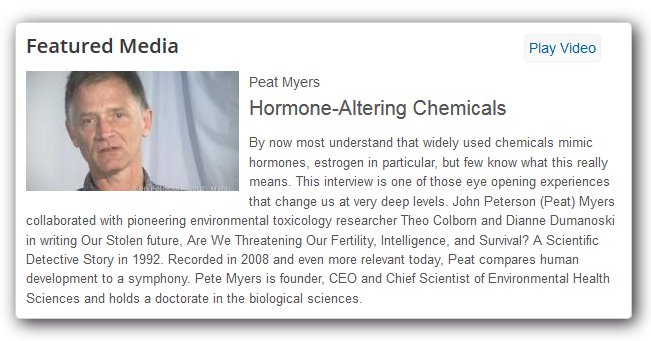
By now most understand that widely used chemicals mimic hormones, estrogen in particular, but few know what this really means. This interview is one of those eye opening experiences. It changed fundamentally how I view and relate to environmental toxins. A must see.

John Peterson (Peat) Myers collaborated with pioneering environmental toxicology researcher Theo Colborn and Dianne Dumanoski in writing Our Stolen future, Are We Threatening Our Fertility, Intelligence, and Survival? A Scientific Detective Story in 1992. Recorded in 2008 and even more relevant today, Peat compares human development to a symphony.
Most people don’t understand how hormones work, what they do, how they interact with genes. It turns out that hormones basic function is to control the turning on and turning off of genes. Genes are active throughout our lives. They’re crucial in guiding development. They have to be turned on or turned off at the right time so the right proteins are present. If this trigger is not there or another is present at the wrong time, you may not have the right number of fingers. Your brain may wind up being wired inappropriately.
Genes are not these passive little things that we just inherit from our parents. They’re active. They’re a symphony throughout our lives. A symphony needs a conductor and hormones are the conductors. Hormones signals are generated by a wide array of factors. Hormone signals guide the turning on and turning off of genes. It’s called gene expression. That’s central to life. We’ve discovered that some contaminants, at extremely low levels (parts per billion) are capable of interfering with the signals that are turning genes on and off. They do that by mimicking hormones or by blocking hormones. In one way or another some contaminants amplify or diminish the signals specific hormones should be sending. They interfere with the degree and timing of gene expression. Some aren’t being turned on or the trigger is happening at the wrong time. Some may be silenced permanently.
What does this mean: BPA has been linked to everything from breast and others cancers to reproductive problems, obesity, early puberty and heart disease. 93 percent of Americans have BPA in their bodies. Recent research shows that exposure to low levels of Dioxin in the womb and early in life can both permanently affect sperm quality and lower the sperm count in men during their prime reproductive years. Exposure to very low levels of the herbicide Atrazine can turn male frogs into females. Atrazine is widely used on the majority of corn crops in the United States, and is a pervasive drinking water contaminant. Atrazine has been linked to breast tumors, delayed puberty and prostate inflammation in animals. Some research link Atrazine to prostate cancer. Phthalates have been linked to hormone changes, lower sperm count, less mobile sperm, birth defects in the male reproductive system, obesity, diabetes and thyroid irregularities so avoid plastic food containers, children’s toys (some phthalates are already banned in kid’s products), and plastic wrap made from PVC. Some personal care products also contain phthalates. And there are more.
Pete Myers is founder, CEO and Chief Scientist of Environmental Health Sciences and holds a doctorate in the biological sciences.
Michael Mendizza
For more information: trusted leaders in this field are Healthy Child Healthy World and EWG. As a program of EWG, Healthy Child Healthy World’s purpose is to empower parents to take action and protect their children against harmful chemicals. Together they inspire parents, promote solutions and influence policy to create a cleaner, greener, healthier world.